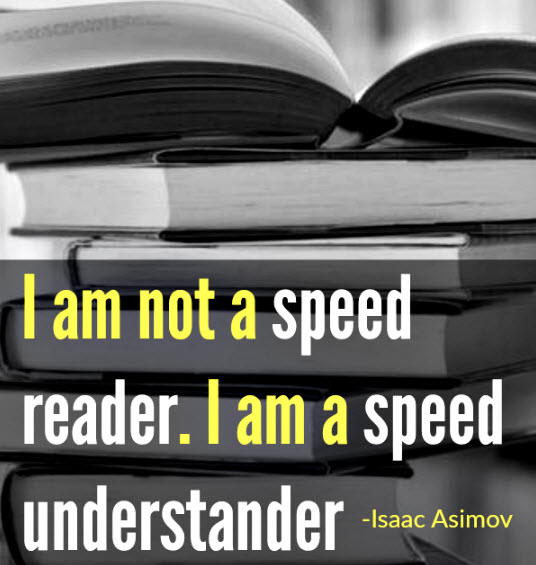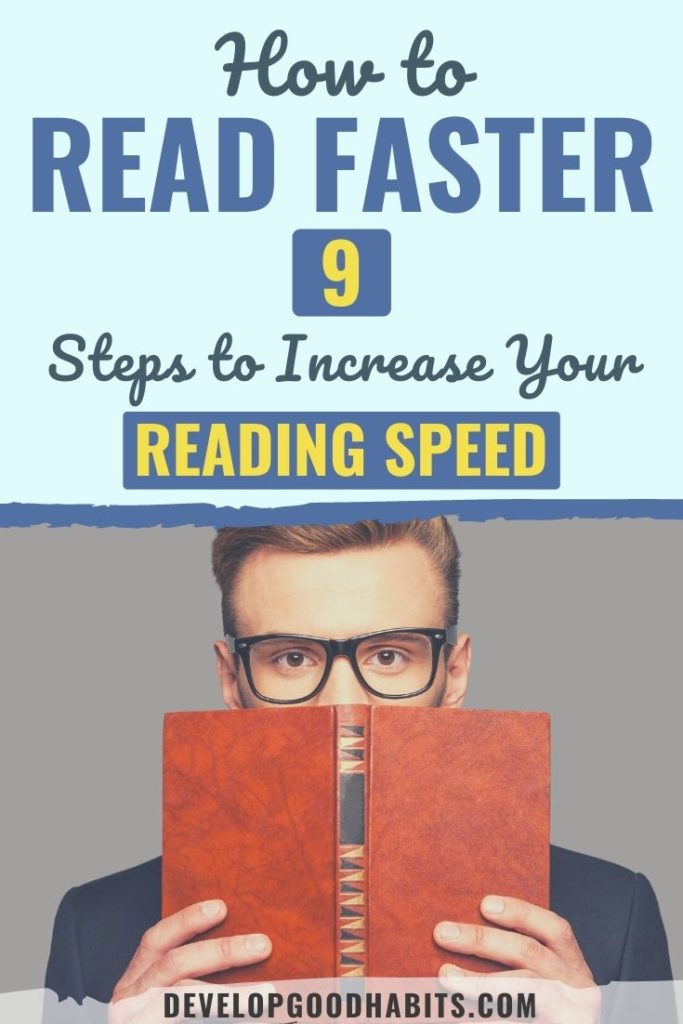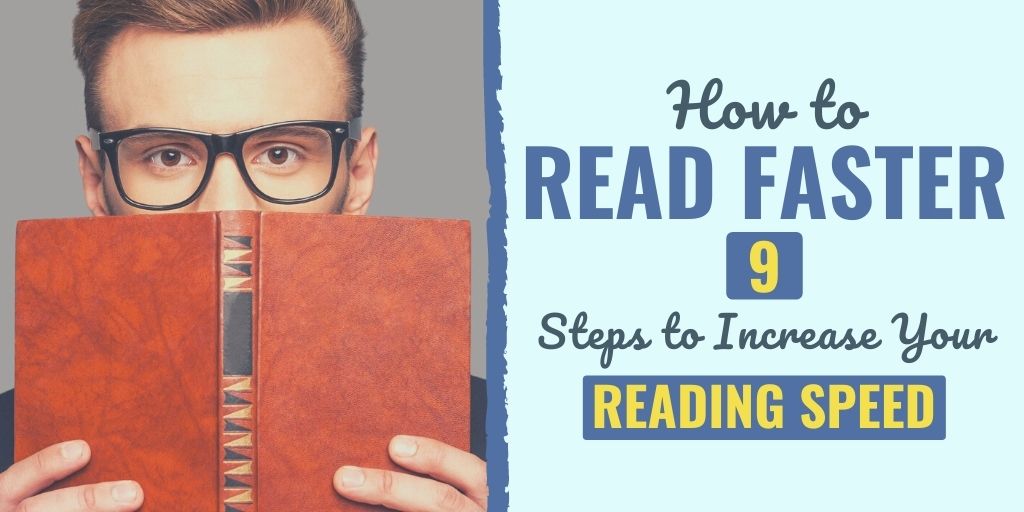There might be affiliate links on this page, which means we get a small commission of anything you buy. As an Amazon Associate we earn from qualifying purchases. Please do your own research before making any online purchase.
Wish you could finish books quickly and effortlessly? Looking to learn how to read faster while retaining what you've learned? While most people believe that speed reading is a difficult habit to build, the truth is it's an art that can be mastered with the right set of exercises and tools.
You'll find that with a little bit of practice, you'll see it's simple to glide through dozen of pages in a few short minutes.
In this article, I'll go through a simple nine-step process you can use to learn how to read faster.
Let's get to it…
Why Should You Build the Speed Reading Habit?
While I'm not the fastest reader around, I have found that improving my speed reading skill has flipped a switch in my brain that's had a lasting impact on every corner of my life. More importantly, I think it's a useful skill for anyone interested in personal development.
Consider this – Think of the one book that has had the biggest impact on your life.
Imagine how your life would be different if you didn't read it. When you learn how to speed read, you effectively increase the likelihood that you will discover that next great book.
Imagine the ability to read ten, twenty, or thirty more books this year without having to spend massive chunks of your day pushing through the pages. If it only takes one book to change a life, thirty books could transform you beyond anything you've ever thought you were capable of becoming.
When you learn how to increase reading speed and comprehension, you can read with no loss. This is an important factor because you do not want to increase your reading speed but not have the material you read to make an actual impression.
RELATED: Habits that Stick!
Want to build a new habit that will stick for the rest of your lifetime? In this video, you will discover a simple 9-step process about building habits that you can immediately implement.
The 9-Step Process to Read Faster and Retain More (an Overview)
So, let's break down the basics and dive into the good stuff…
When it comes to reading speed, the two more important tools are your eyes and your mind. Your eyes see the words, and your mind processes the sentences. The average reading speed of an adult is 250 words per minute. However, some are naturally faster than others if they push it and can double this rate.
Unfortunately, most people never push the limits of their eyes or mind. What happened instead was they learned to read at a young age, slowly developed the skill over the years, and never considered that there was a way to train themselves to read faster.
Think about it this way – In the military, higher education, surgery rooms, and life-or-death situations, we know consciously that we want to prepare to the best of our abilities. If reading a book has the power to transform our future, why wouldn't we want to read at our best?
To speed read, you have to pay attention to what your eyes are doing while you read.
Your eyes have to move from left to right to read a sentence. That part is simple, but most people seem to miss out on the fact that they can train their eyes to move faster.
You could simply look at a sentence and scan it from left to right as quickly as possible, and you'd be exercising the muscle that controls your eyeballs.
So, the first step of becoming a speed reader is to recognize that our eyes become faster and more prepared to read quickly by exercising and practicing with this scanning motion. It's just like working out a muscle; do it constantly, and it will grow stronger. Unfortunately, that's probably not how your eyes work yet.
As you read, you occasionally dart back to the left or skip ahead slightly and have to readjust your eyes while you read. There's no fluidity. More importantly, you probably never attempt to speed up the motion of your eyes.
From that simple understanding, the trick is to create a few new habits that will quickly, effortlessly, and enjoyably develop the skill. Once that's done, the rest is a breeze.
To give you an idea of what we'll cover, here's a great infographic that covers the basics of speed reading:
Let's dive into the nine-step process…
1. Learn How to Read Without Subvocalizing
Welcome to the hardest and most crucial habit to tear down. When it comes to building your reading habit, we are often limited by the time it takes for our subconscious mind to pronounce the words on the page. We don't say them out loud, but our mind speaks them unconsciously: This is known as “subvocalizing.”
When we speak a word out loud, that takes a certain amount of time to pronounce. However, we do not actually need to pronounce words when we read. We can simply absorb them.
Have you ever found yourself reading a sentence quietly, but your lips still mimicked what it would be like to say the word aloud? That is subvocalization.
Unfortunately, the habit of speaking words as we read them is often so deeply embedded in our unconscious mind that the idea of breaking free of it seems impossible.
A great trick is to pick out any word in this text and look at it for a moment in total silence. There will still be a slight bit of sub-vocalization, but by merely observing words without using the voice in your head to pronounce them, the new habit will begin to form on its own.
A great tip for defeating this step is to start looking at and thinking about words without the need to pronounce them. This part might feel obscure or abstract in the beginning, and that's totally normal. All you need to be concerned with is looking at words without the desire to hear the way they sound.
After a little bit of practice, perhaps a few hundred words, you'll notice the difference between using the voice in your head and simply allowing it to enter your mind. And once that's done, you've torn down the biggest barrier between yourself and speed reading.
It might not be easy at first, but everything else is cake by comparison once you've beaten this part.
2. Determine Your Current Baseline
Another crucial element of speed reading is recognizing your own growth.
Before you can measure your growth, you will need a baseline. Then once you have a baseline to measure, you will need to periodically measure your reading against this baseline.
A great resource for tracking your results can be found at ReadingSoft.com, which provides rapid, consistent measurement of how quickly you're reading. By regularly taking the tests here, it'll be much easier for you to recognize that you're growing, which will provide all the motivational fuel you'll need to keep going.
The problem with understanding your own baseline is that it's hard to translate it into practical terms when a program says that you're reading a certain amount of words per minute. It's a great place to start, but from a practical perspective, it's more important to know how many minutes it takes to read an average page.
If the average person takes 5 to 10 minutes per page, a speed reader doesn't need much more than 2 or 3. This means that a 200-page book comes out to 400 minutes for a speed reader and 1,000 to 2,000 minutes for the average reader.
That means the average reader has to spend an extra 13 hours on the same book. That's more than half a day in lost time! However, it's not as easy as just jumping from being a 17-hour reader to a speed reader. There will be various obstacles in your way, but fortunately, most of them are easily dealt with.
3. Use a Pointer, Indicator, or Your Index Finger
Using a finger to guide yourself while reading is often considered to be reserved for children and then forgotten once they have the hang of reading. However, this trick comes in handy again while learning to speed read for a few key reasons.
The biggest and most important hurdle in speed reading is not learning new skills but removing old skills that work against us.
One of these skills that works against us is our comfort in reading without a guide, but to learn as quickly as possible, using a guide is a must. It is absolutely non-negotiable.
If you were to observe me speed reading, you would notice I do not need to use a guide, but my eyes are constantly darting from the beginning to the end of the line. You would not notice that I am doing so at a very consistent speed.
In other words, the amount of time that it takes me to cross a single line of text is mostly the same as I continue my way throughout the page. The exception here is when I have an epiphany or get confused, but both are still natural parts of reading.
When using a guide as one of your speed reading techniques, your primary goal is to move the guide consistently. You should not stop your finger or slow it down. It should simply slide from one side of the text to the other at a very uniform speed, moving your eyes to keep up.
By practicing in this way, you're going to be able to notice when you get stuck or lose momentum much easier than if you simply tried to follow along and move as quickly as possible.
When you just try to move quickly, you cannot maintain a fluid and flowing form of speed reading because you will eventually hit your limit and skip a word. This results in backtracking, and backtracking results in confusion.
Doing this twice per page could easily add 30 seconds to each page or 100 minutes to a 200-page book. That's an extra hour and a half lost to backtracking over the span of an entire book. You must learn to think of speed reading as a marathon rather than a race.

4. Focus on Control
When moving through text, you will come to find that certain sections of a book might be a breeze to read through, while others are too full of useful information to read quickly.
This is a natural part of reading, and transitioning smoothly from thick material to easy reading is a measure of control. Remember, speed isn't the only important part of speed reading: You still have to do the actual reading.
Let's take two separate books to illustrate this point.
The first book will be a thick, boring history textbook. If we needed to find specific dates and names within the book, it would be easy to just speed read through the pages while scanning for the names. If we needed to find the significance of these people and dates, we would need to slow down and absorb the material a little bit more closely.
Our second book is a fiction book. It's a whimsical story about a family trapped on a mountain and their adventures trying to find the way off of it.
Because our brain enjoys the book, there is no real reason to control the reading process unless we don't understand a part of the story. We may simply breeze through the text, let the story fill our mind, and slow down when we feel we have missed out on something significant.
In this light, speed reading obviously has different implications for different books. The rookie makes the mistake of believing that speed reading is all about speed, but it is fundamentally about reading. The speed aspect is simply the ability to control one part of how we read.
5. Train Your Eyes to Minimize Movement
One of the biggest and easiest epiphanies in your journey to becoming a speed reader will be recognizing how much your eyes move while you read.
The average person's eyes cannot keep moving in a single, fluid line without needing to backtrack. Things come into our peripheral vision and distract us. If you begin to pay attention to your eyes, I can guarantee that you will start to notice just how often you move back, then forward, then back again, with less distraction.
In the long run, this movement can add entire hours to your reading experience, and it might even prevent you from finishing in the first place.
[Get a more detailed information on speed reading from one of these seven top-rated speed reading books.]
Train Your Eyes Without a Book:
A great exercise that doesn't require a book is to practice moving your eyes from left to right while also moving your head from left to right.
By doing these exercises, you have just isolated all of the core components of using your eyes to speed read. We have motion created by the head that does not affect the eyes, motion created by the head that is shared with the eyes, and motion created by the eyes that does not affect the head.
Keeping your eyes fixed in place, like in the first exercise, helps with focusing on a single word or phrase that you might want to slow down to read. Like in the second sentence, moving your eyes with your head helps create relaxed and fluid motion as you transition from line to line or page to page. Moving your eyes independently, as in the third exercise, is the core of scanning from one side of the line to the next.
By teaching your eyes to scan in straight lines and using the motion of your head to add that extra layer of control to the mix, you will be able to comfortably maneuver your eyes across the page at speeds you never thought were possible.
If you want a to practice this skill, here are “eye exercises” for speeding (with some seriously cheesy club music):
6. Skip Small, Unimportant Words
To understand how speed readers get so fast at moving through pages, it's absolutely crucial to realize that not every word is created equal. There are plenty of small, obscure little words that don't help you, and trying to force yourself to read them can only hurt.
If we go back to our understanding that an extra thirty seconds per page can translate to an entire hour and a half, imagine what can be done when we eliminate all of the “if,” “is,” “to,” “the” and other small-yet-insignificant words. It follows the same concept of saving time, but it is an entirely different skill to develop.
The best part of skipping the small words is that they do not contribute anything useful, so skipping them effectively means that you are getting more out of your reading experience.
Cool, huh? By skipping words, we're getting more. Let that sink in for a moment.
Training yourself to skip the small words is as simple as recognizing that you don't need to pay so much attention to them. Simply allow your eyes to continue moving across the unimportant words.
Over time, your brain will naturally learn to skip over them for you when fast reading, and you can start scanning and skimming sentences while skipping a significant amount of insignificance.
7. Practice Using Powerful Software
The best tools for speed reading practice are simple, common apps that streamline the process of learning the skill.
There are a few different options to choose from, and most of them provide excellent features that make using them both an exercise in speed reading and a way to save time.

This is an iOS 8 app that allows you to import articles, documents, and other texts and links into a speed-reading practice app. It doubles in value as both a practice tool and a learning tool because by incorporating articles that you'll already want to read, the practice doesn't feel tedious or mechanical.
Instead, it just feels like reading an article while working on your speed reading. Accelerator is highly recommended.
This excellent tool allows you to copy and paste anything you'd like into a small word processor. The app then takes whatever you've already pasted and turns it into its own exercise, allowing you to pick and choose exactly what you'd like to read and practice on in the same app. It's a perfect choice for those looking to get a lot of value without ever spending a penny.
Spritz is a little bit different than some of these apps. Spritz doesn't exactly teach you how to read faster it teaches us to use its software to reconfigure the things you want to read in an entirely new way.
Spritz reading is all about not moving your eyes. It flashes the words in from of your eye, highlighting one letter to center each word to keep your eyes tracking the words as they flash past at what seems like light speed.
I have only tested it using the Spritz demo. But I found I fully comprehended the text even at a blazing fast 700 words per minute. But perhaps this reading might be tiring if you had to read an entire book's worth of material. Spritz is certainly one of the more interesting speed reading tools.
For those with an eReader, ReadMe! is a fantastic choice. This app offers a ton of functionality, but it's specifically designed to assist with speed reading through ebooks. Since modern technology has made ebooks one of the most convenient ways to read, this one is extremely recommended for everyone from kids to professionals.
And finally, Acceleread is like a swiss army knife of speed reading tools. While most of the other apps listed here have import features or work with specific text forms, Acceleread is a true-blue speed reading trainer designed with its own exercises.
This one aims to concentrate on the exercises themselves for faster growth, rather than to import text that you might want to read and make you practice with that. This one is like going to the gym for speed reading.
Related Reading: Here are more speed reading apps we have reviewed.
8. Practice Scanning and Skimming Text
You've already heard most of what you need to know by this point. That's right; you already understand the core skills needed to start speed reading your reading material.
However, practice does indeed make perfect. To learn this precious skill, you need to start getting used to scanning through pages upon pages of words.
At first, the skill will come slowly, but it will inevitably become easier over a few days. You'll be better in five weeks than you will be tomorrow, so relax and enjoy the ride; you'll get there eventually.
For a fantastic and more thorough write-up on the value of practice in speed reading, check out this excellent resource. It outlines the type of practice you can do to develop your skills, but it also provides lots of different tips and perspectives for becoming a more refined speed reader as well. Just remember that practice makes perfect, and the time that it takes to develop will fly right on by.

9. Continue to Practice and Time Yourself
If you've made it this far, congratulations – You have everything you need to handle this on your own now. It might seem like speed reading should be this ridiculously difficult skill to master, but it isn't. It's just a few key understandings and a lot of practice to increase your reading pace.
At this stage, your primary goal is to time yourself regularly and continue to practice the techniques that are discussed here in the article.
Consider bookmarking this for future reference, and come back every once in a while to reread the page and see if there's anything you missed the first time around.
If you want to learn more, check the best books about speed reading.
Tips on How to Retain More Information
What does Warren Buffet have to say about reading? “I just sit in my office and read all day.” This is how one of the most successful people in the world describes his day. He recommends that everyone should read more and make it a habit.
So, how do you speed read but still retain more of what you're reading? It also comes down to impression, association, and repetition. Follow these tips.
Impression
When reading and wanting to retain what you are reading, be impressed with it. While reading, picture a scene in your mind and then add elements that help make your impression of the text stronger. You can even try to read a few passages out loud.
Association
With association, you link what you're reading to something you are already familiar with. This technique is often used for memorization and the construction of memory palaces. So, if there is something, in particular, you want to remember, then associate it with a more specific example that involves the same principle.
Repetition
According to Mortimer Adler's book entitled How to Read a Book, there are four levels of reading. These four levels are elementary, inspectional, analytical, and synoptical. As you go through each level, you will use different brain techniques regarding impression and association to enforce repetition and enhance reading comprehension.
Improve Your Vocabulary
When looking to improve your reading comprehension skills, you should also improve your vocabulary. Knowing the meaning of words can significantly improve your reading comprehension.
Ask Questions
Next, come up with questions about the reading material. This means you are invested in what you are reading, so you are more apt to explore themes and other key ideas in the text. For example, why did the author choose that particular location? What do you know about the main character?
Use Context Clues
Context clues can also help improve reading comprehension. Focus on key ideas and phrases and deduce the main idea with just this information.
Break Up Longer Text
Finally, it can also help to break up your reading material into smaller sections. This is especially helpful if the text is more complex. After reading each smaller section, take a few minutes to summarize what you read.
In Closing
It's important to realize that this very guide might be the key you need to take your life to new heights. Think about the wealth of knowledge that has been written since humans picked up the pencil and got to writing: That's all at your disposal now.
You have everything you need to read through some of the most powerful and helpful books you can find, and you can do it faster than all your friends, relatives, acquaintances, and enemies.
All of the information contained in this list has been invaluable to me. If I need to learn something about jet skis, I can do it in record time. If I need to learn a language, I can scan through the pages and find the most valuable information as quickly as possible.
But most importantly, if I ever feel the desire to expand myself, I can do it in a reasonable amount of time. It doesn't take me 15 hours to get through a simple book anymore, and that's a profound change. I could not begin to imagine where my life would be now if I had never learned how to read faster.
I sincerely hope you enjoyed this tutorial and wealth of information, and I wish you the best of luck in your journey to faster reading that suits you best. If you're wondering whether it's better to read in the morning or at night, check out this article. Or, if you want to improve your focus, check out this post on how to concentrate better while reading.
Please feel free to share this with any of your friends that want to learn, have yet to discover their passion, or that you personally think would like this. I'm very interested in hearing your opinions on this piece as it hit close to home, so please feel free to drop a comment, and you can be sure I'll read through it very, very quickly.
That was a speed reading joke. 🙂
Finally, if you want to take your goal-setting efforts to the next level, check out this FREE printable worksheet and a step-by-step process that will help you set effective SMART goals.




Glad to have the addition Michal. I know you have a great deal of experience with speed reading, having literally, “written the book on the topic” https://www.amazon.com/Learn-Read-Great-Speed-Reading/dp/150847382X Which I encourage anyone interested in reading fast to check out…
Great tips!
Most important techhnique to be mastered are skimming and Avoiding subvocalization.
Certainly at higher speeds comprehension is affected but while reading novels its more important to understand and get the concept and jest of it rather than comprehending it word by word.
Skimming can help in reading web articles at very high speeds and can improve reading speed to 1000WPM.
yeah I totally agree. once I used a website, acereader.com, and checked my speed and it was a whooping 6657WPM
Great Article!!
I always wondered some people reading so fast in my college,i joined the community and slowly learned about the courses they are using, definitely some techniques worked and i was able to multiply my reading speed,some techniques worked very well like skimming, Pointer technique and avoiding subvocalization, although its a matter of practice its a skill certainly need to be learnt and i am very happy now as i enjoy book reading always,catch more tips and tricks
Good sound tips. From my experience of 16 years teaching speed reading and photoreading I strongly believe that the most important technique is the PURPOSE for reading which is the fourth technique in our Spd Rdng Bible
Having a clear purpose for reading establishes what specifically you want to extract from any material and how. Reading fast without a purpose is like driving fast for no reason or without any destination (it might be fun but what’s the point – unless the fun is the purpose). Most books on speed reading put so much emphases on the speed of reading and not enough on strategies for getting information that you need. We teach a range of reading speeds from 300wpm to 20.000wpm (yes, 20 000 words per minute – and I can read any book on speed reading at that rate:) depending on what you’re reading, what you already know and what you need, etc. You can be a slow reader and get more and better quality of information quicker that somebody who is a fast reader. How? Because you will have 37 practical strategies and techniques that will help you overcome the limitations of your reading skills.
Hi, I wanted to know how practising on these apps will help in speed reading. Like I use accelereader and it flashes words in chunks on my screen at a speed defined by me but that will not teach me to move my eyes through a document/book I am reading on my phone or computer.
Agreed those apps are great to force you to read fast… but they don’t really teach you how to do it outside of the app.